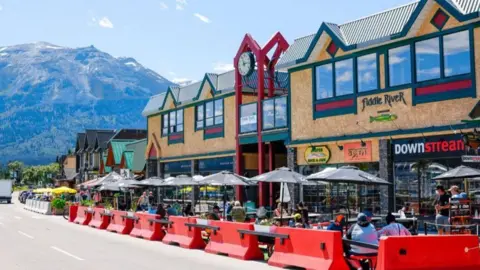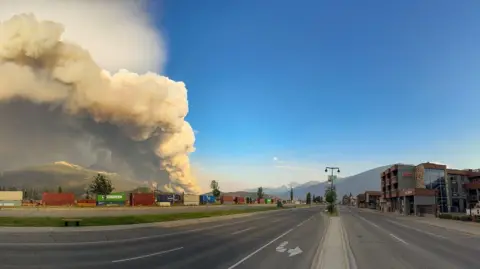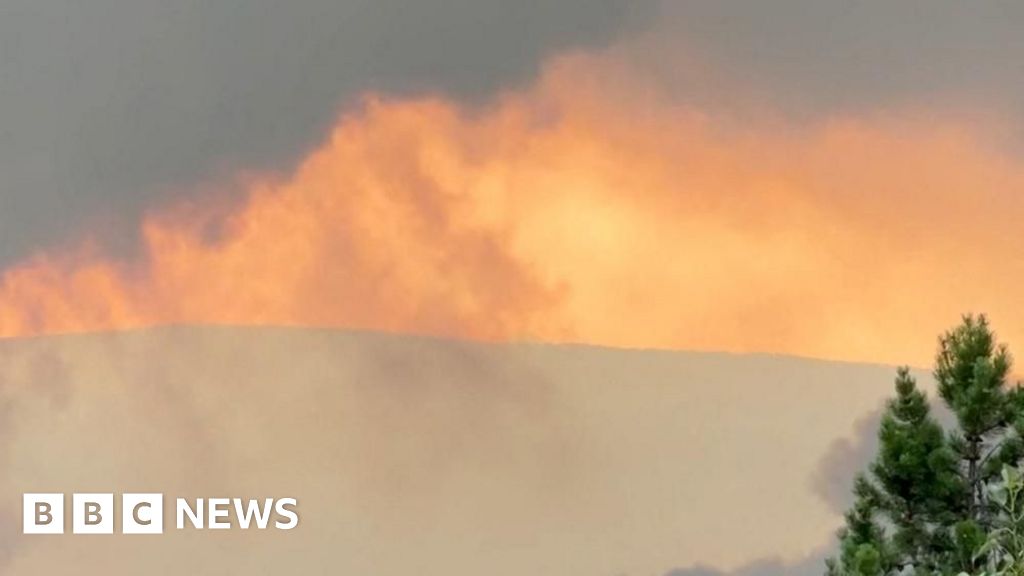A massive, fast-moving wildfire has destroyed half of the historic Canadian town of Jasper and remains out of control as firefighters try to save as many buildings as possible, officials said.
Entire streets in the main town of Jasper National Park in western Canada have been leveled by fire, with footage showing once-standing homes reduced to smoldering rubble and the charred remains of cars.
Although no deaths were reported, about 20,000 tourists and 5,000 residents have fled the mountainous region of Alberta, which has been popular with tourists for decades.
During a news conference on Thursday, Alberta Premier Danielle Smith broke down in tears and at times struggled to describe the scale of the damage but said “probably 30 to 50 per cent” of the buildings were destroyed. destroy.
“There’s no denying that this is the worst nightmare for any community,” she said, adding that Jasper National Park has been a “source of pride” for many generations.
Ms. Smith became visibly emotional as she described the park’s beauty and its importance to a community that relies largely on tourism. About 2.5 million people visit the park and nearby Banff National Park each year.
Karyn Decore, owner of the Maligne Lodge in Jasper, was on vacation when she learned her hotel burned down. On Wednesday night, she received a photo of the building on fire.
“When I saw that picture I was shocked and appalled,” she told the BBC. “I think it will take a few days for the shock to wear off.”
“It’s hard for everyone to understand that we lost a property,” she said, adding that she planned to rebuild the cottage.
 Jasper Tourism
Jasper Tourism BBC reporter Wendy Hurrell was in Jasper National Park when the fire started burning on Monday. She drove through the night with her husband and daughter and hurriedly left the town.
“The storm was very violent – the sky turned crimson, strong winds, heavy rain and lightning,” she said.
“We were one of the last travelers to enjoy the beauty of Jasper and it will take a long time to recover. This is devastating for them all and my heart is broken.”
Hundreds of firefighters from around the world have been deployed to help with the response, but officials warned the extent of the damage was still emerging. They said Thursday’s focus was on controlling the fires that were engulfing the town from both sides.
Pierre Martel, director of National Fire Management Programs for Parks Canada, said the fire was started by a thunderstorm and escalated Wednesday night as strong winds fanned it.
“it [was] At that point it was just a monster,” Mr. Martel said. “We didn’t have any tools in our toolbox to deal with it.
One official said the flames were as high as 100m (328ft) in some places, “covering a huge space in a very short period of time”.
 jasper national park
jasper national park Mike Ellis, Alberta’s public safety minister, said the fire was 5 kilometers (three miles) outside Jasper and was blown to the town “in less than 30 minutes” by the wind.
“Any firefighter will tell you that when a wall of fire comes at you like this, there’s very little you can do,” he said.
“No one expected the fire to come so fast, so big, so fast.”
Canadian Prime Minister Justin Trudeau thanked emergency services for their response to the wildfires.
“As heartbreaking images emerge from Jasper, I want to thank Alberta’s brave first responders who are working to save every family and every community,” he said.
Environment Canada says the hot, dry conditions that have fueled the spread of fires may soon ease, with rain expected later Thursday.
This marks another year of severe fire conditions for the province. Between March 1 and October 31 last year, a record 2.2 million hectares were burned in Alberta.
In addition to Alberta, there are more than 45 active fires in British Columbia, and fires are also burning in California, Oregon, Washington state, Montana and Utah in the United States.
The total number of fires around the world has decreased over the past two decades.
But researchers say climate change could bring more lightning to forests in the Earth’s north, increasing the risk of wildfires.
Additional reporting by Eloise Alanna and Ottilie Mitchell


